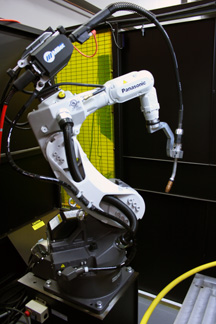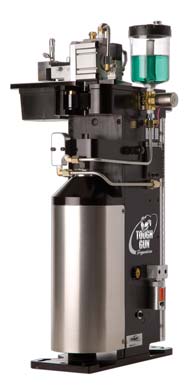FAQs About Robotic Peripherals Answered

Automated welding systems add speed, accuracy and repeatability to the welding operation. They can help operations increase productivity and reduce costs in a relatively short period of time. But these results don’t happen by accident; they require careful equipment selection, system integration and training — including the selection of peripherals.
Peripherals refer to the additional equipment that is integrated into the automated welding system to maximize its performance. The selection and implementation of the proper peripherals should be a part of the welding automation plan upfront, not later after the system is in place. Incorporating peripherals early in the process can result in more efficient throughput, long-term cost savings, better quality welds and minimized downtime.
Consider these frequently asked questions about peripherals to clarify their role in the welding operation and better understand their benefits.
Why is a nozzle cleaning station important?
A nozzle cleaning station (also called a reamer) cleans spatter from the inside of the welding consumables on the front-end of the MIG welding gun, including nozzles, contact tips and retaining heads.
There are several benefits a nozzle cleaning station can offer. First, by keeping the nozzle clean, this equipment helps reduce the risk of losing shielding gas coverage that could potentially lead to expensive re-work. Secondly, it helps lengthen the life of the consumables (nozzle, contact tip and diffuser or retaining head) and the robotic MIG gun. Longer equipment life translates into less downtime and also less cost for equipment — both factors that contribute positively to a company’s ROI of its automated welding system.
What’s the benefit of adding an anti-spatter sprayer to a nozzle cleaning station?
An anti-spatter compound (typically in liquid form) can provide additional protection to consumables. A sprayer applies the anti-spatter compound to the front-end consumables after they have been cleaned. In many cases the sprayer can be mounted on the nozzle cleaning station, integrating it into the overall process of nozzle cleaning.
Recall that the rule of “less is more” applies. Excessive anti-spatter usage can lead to unnecessary costs and the compound may build up on the nozzle, the welding robot and the parts being welded. In the long term, a high spray volume could cause additional problems that are just as harmful as spatter build-up itself.

How can a wire cutter help the operation?
Many robotic welding applications require consistent welding wire stick-out (also called electrode extension) when the arc initiates. A wire cutter can help maintain that consistency.
As its name implies, a wire cutter cuts the welding wire to a specified length and it also removes any inconsistencies at the end of the wire, resulting in more reliable and smoother arc starts. For companies that program their robot to seam track (or find the joint) through touch sensing, the consistent wire stick-out allows for more reliable and repeatable welds by helping the robot to more easily locate the correct spot to begin welding.
Most wire cutters are capable of cutting different types of welding wire, including stainless steel, flux-cored and metal-cored, usually up to 1/16-inch diameter. Companies may prefer to mount the wire cutter on a nozzle station or locate it remotely, according to their needs.??
How do neck inspection fixtures work?
This peripheral verifies that the robotic MIG gun’s neck is set to the intended tool center point (TCP), allowing it to be readjusted after a collision or if the neck becomes bent due to routine welding. Most inspection fixtures will accommodate standard necks for a particular brand of robotic gun.
After determining the tolerances for the program, a trained welding operator simply adjusts the neck to meet the correct specifications. This adjustment helps prevent costly rework due to missing weld joints and can help prevent the downtime to reprogram the robot to meet the welding specifications with the existing bent neck. For companies that maintain a large number of robots, a neck inspection fixture can also help prevent confusion when exchanging necks from one robotic MIG gun to another. Welding operators simply remove a bent neck, exchange it with a spare that has already been inspected and adjusted, and put the robot back in service immediately. The damaged neck can then be set aside for inspection while the robot is still online.
How can peripherals help protect against collisions?
In cases where collision detection is integral to the robot, a solid arm mount can help protect against a collision. As its name implies, a solid arm mount is just that: solid. It does not provide electrical feedback during an impact, but rather relies on the software to stop the robot during an impact.
For robots without collision detection, a clutch may be added to the system. The function of a clutch is both mechanical and electrical. It recognizes the physical impact of the collision and then sends an electrical signal back to the robot controller, causing the system to stop. This action prevents damage to the robot and the robotic gun. It also alerts the welding operator overseeing the operation that there is an incorrect variable in the weld cell.Both clutches and solid arm mounts require mounting arms to attach them to the robotic MIG gun and hold it in a specified position, so the robot can repeat the same weld throughout the welding process. These mounting arms are generally composed of a durable aluminum alloy that can resist breakage during an impact.
Although the addition of peripherals to an automated system does add to the initial cost of automating, this equipment can lead to measurable savings in the long term. Since the goal in automated welding is repeatability and increased productivity, any additional equipment that can help achieve that result is worth the consideration.


